Best DDR4 RAM: Fastest memory for your AMD PC or Intel
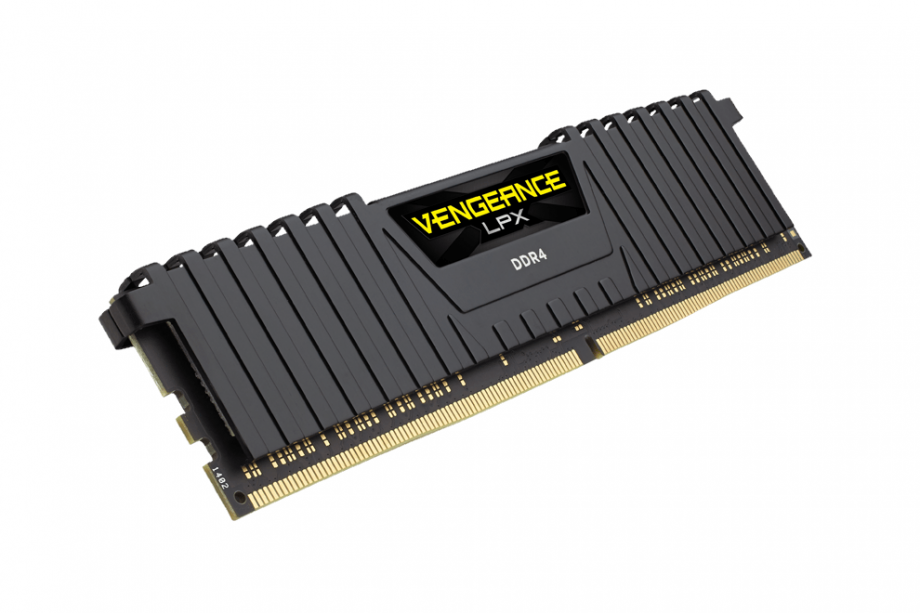
Best DDR4 RAM 2020: Building a PC? We test the best RAM options out there and compare the results.
Which is the best DDR4 RAM to buy? Here are the best we’ve reviewed in our group test
Out of the 15 kits that we tested, there are three that stood out. The Corsair Vengeance LPX 2 x 8GB is the best high-end DDR4 kit we found on the market. This high-end kit is designed around performance rather than aesthetics, and is certainly the best when it comes to high-end speed and performance. If you’re on a budget, then the Crucial Ballistix Sport LT White 2 x 8GB would make an excellent choice. We’d also recommend the Team Group Dark Pro 2 x 4GB as another good affordable alternative.
1. Corsair Vengeance LPX 2 x 8GB (CMK16GX4M2B3200C16)
The best high-end DDR4

Key features
- Review price: £173 for 2x8GB (£10.81/GB)
- Also available: £115 for 2x4GB (£14.75/GB) and £361 for 2x16GB (£11.28/GB)
- 3200MHz speeds
Why we liked the Corsair Vengeance LPX 2 x 8GB (CMK16GX4M2B3200C16)
This kit is our favourite high-end DDR4 product, although we’ll concede that it doesn’t look like it. Corsair’s memory modules are coated with plain, slatted heatsinks made of solid aluminium, and they’re low-profile too – so these DIMMs are some of the smallest I’ve ever seen.
This isn’t necessarily a bad thing. The lack of RGB LEDs means there’s more room in the budget to make the memory faster, and the smaller design means it will be easier to install chunky cooling hardware without the memory getting in the way. This kind of design certainly goes against the current trend for big sticks of memory with plenty of lighting, but I’m happy to forego RGB LEDs if it means my memory is quicker and more reliable.
Corsair’s kit is designed around performance rather than aesthetic features, so it’s no surprise to see it running at 3200MHz – one of the highest speeds in this group. Elsewhere, latency comes in at 16-18-18-36, and the kit is available in white, blue or red variations to match your machine.
This 16GB Corsair kit costs £173, which brings it in at £10.81-per-gigabyte – right in the middle of my high-end group. It’s also available in different capacities. A version with two 4GB sticks costs £115, and a 32GB kit is a whopping £361.
The decision to concentrate on speed rather than performance has paid off. The Corsair’s single-threaded bandwidth figure of 15.45GB/sec is one of the best here, and its global latency result of 28.9ns tops the table, along with the Team Group Night Hawk RGB kit.
The Corsair memory delivered the high-end group’s best results in the single- and multi-threaded cache bandwidth benchmarks, and its Cinebench multi-core score of 2194cb is the best of any high-end kit in this group.
Its Geekbench results were barely behind the Team Group kit, but better than my three other high-end picks. Its 3DMark: Fire Strike score of 6817 was fine and better than the Night Hawk memory.
The Corsair kit delivered a Ghost Recon average of 37.26fps. That’s right in the middle of the high-end group. Other kits in this group are a little quicker, but they tend to be slower in many other benchmarks – and so, for all-round performance, that’s no good.
Corsair’s kit isn’t just fast – it’s consistent, too. Its theoretical results are often the best in the high-end group, and no other expensive kit can offer the balance and speed that Corsair has served up across real-world application and gaming tests. It doesn’t have snazzy RGB LEDs and other eye-catching features, perhaps, but this is the top kit when it comes to high-end speed and performance.
Latest live deals
2. Crucial Ballistix Sport LT White 2 x 8GB (BLS2C8G4D26BFSC)
Excellent budget DDR4
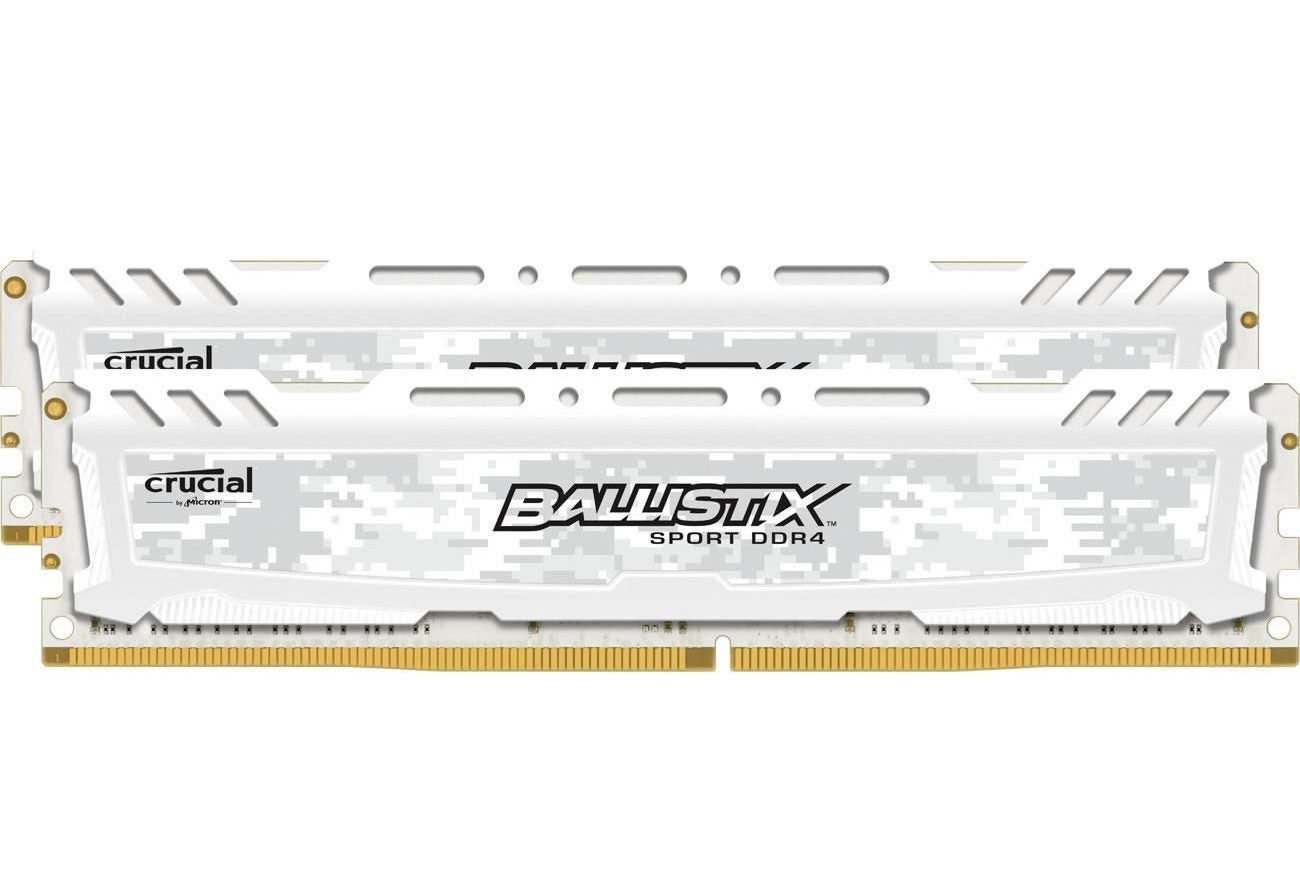
Key features
- Review price: £149 for 2x8GB (£9.31/GB)
- Also available: 2x4GB for £72 (£9/GB)
- 2666MHz speeds
Why we liked the Crucial Ballistix Sport LT White 2 x 8GB (BLS2C8G4D26BFSC)
The Crucial Ballistix Sport LT White memory is one of the most affordable kits in this test, at just £9.31 per gigabyte, but that doesn’t mean you lose out on looks. The compact sticks are made of white, camo-patterned metal, and they’re topped with neat cut-outs.
You don’t lose out on features, either. There’s 16GB of capacity, and the Ballistix Sport rattles along at 2666MHz – right in the middle of the range of DDR4 speeds, and fast enough to ensure that this DDR4 doesn’t lose much ground when compared to pricier kits.
This kit serves up latency of 16-18-18, and it doesn’t have ECC certification – no surprise for an affordable consumer kit. If you’re interested in the equivalent memory but in a more affordable 2 x 4GB configuration then it will cost £72, or £9 per gigabyte.
The Crucial’s SiSoft Sandra bandwidth figures of 15.3GB/sec and 32.48GB/sec are marginally slower than the Corsair Dominator Platinum Special Edition and Team Group Dark Pro kits, but both of those products are more expensive; and in this category, I’m looking at value. Also bear in mind that the Corsair kit is a 32GB product, rather than 16GB product.
The Crucial’s instruction latency speed of 13.6ns is one of the best from my budget group, and its 51.32GB/sec single-threaded cache bandwidth result is similarly impressive.
The Ballistix’s theoretical results were decent, and its application pace was better. Its Cinebench multi-core result of 2181cb is one the best of any of the budget kits, and no other kit could offer faster and more balanced pace in the Geekbench tests.
The Ballistix kit may be one of the most affordable kits, but benchmarks indicate that it still offers ample performance in the majority of tasks – this 16GB, 2666MHz kit will handle applications and work, with few bits of software that really need anything more in your average, consumer-grade system.
There’s one caveat – and that’s gaming. The Crucial’s Ghost Recon average of 37.14fps is the worst of any budget kit, and is more than a frame per second behind the Corsair and Team Group products. It isn’t going to make or break a gaming rig, but it’s worth bearing in mind.
That’s the only black mark against these attractive RAM modules, though. It’s consistent and fast in application tests and returns solid results in theoretical benchmarks, plus it’s a little cheaper than other budget kits that are occasionally a bit quicker. That makes it the affordable DDR4 choice.
Latest live deals
3. Team Group Dark Pro 2 x 4GB (TDPRD48G3000HC15ADC01)
An excellent £10/GB choice
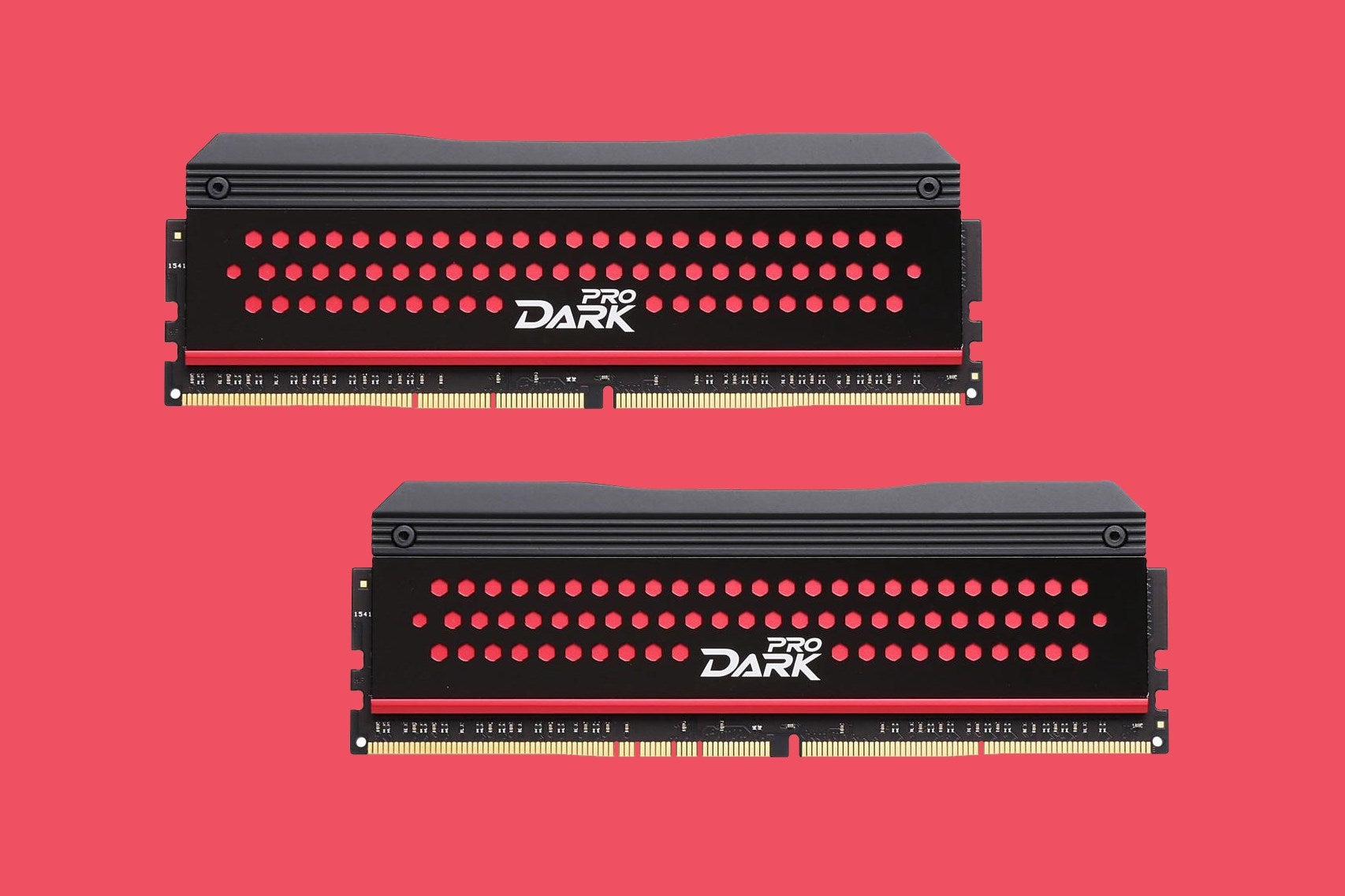
Key features
- Review price: £80 for 2x 4GB (£10/GB)
- Also available: £140 for 2x 8GB (£8.75/GB)
- 3000MHz speeds
Why we liked the Team Group Dark Pro 2 x 4GB (TDPRD48G3000HC15ADC01)
Oddly enough, the best mid-range kit also offers one of the smallest capacities in the entire group – a modest 8GB spread across two sticks.
Instead of increasing size, Team Group has ramped up the speed. Its 3000MHz classification puts it right at the top of the table when it comes to mid-range DDR4 kits.
Team Group’s 8GB costs £80, which works out to a cool £10 per gigabyte. This is a little more expensive than some of its rivals, but not by enough to dent your wallet. Pleasingly, the 16GB variant costs £140, which works out at a cheap £8.75 per gigabyte.
This kit serves up 15-15-15-35 latency figures, and it certainly looks the part. It arrives in a smart box, and the sticks themselves are made of black metal, with a chunky heatsink on top and milled red hexagons down both sides. There’s no lighting, though – you’ll have to pay a bit more for that.
The Team Group kit looks good and performs solidly. Its single-threaded bandwidth figure of 16.08GB/sec is the best of the mid-range group and is the only kit to get beyond 16GB/sec. In addition, its global and instruction latency results are the fastest here, which means rapid response times.
Other mid-range kits have better single-threaded cache bandwidth than this product, and its multi-threaded throughput is similarly solid.
The Team Group’s Cinebench multi-core result of 2200cb is the best in the mid-range group, and it led the way in that app’s OpenGL test too. It also dominated in both Geekbench tests.
It’s more middling in gaming, but that’s our only issue. If that’s important to you then the Corsair Vengeance RGB is a better mainstream option.
It’s hardly going to ruin gaming experience, though, because we’re talking about fine margins in these benchmarks – and in the rest of our tests the Team Group is super-impressive. Despite its 8GB capacity it’s the fastest mid-range kit in most of the benchmarks, and that makes it a clear winner.
Best of the rest – Low-end
We may have picked Crucial’s Ballistix Sport LT as my favourite budget kit, but that product isn’t the only one worth considering if you need affordable memory.
The best runner-up is Team Group’s Dark Pro (TDRPD416G3200HC14ADC01), which is a 16GB kit that runs at 3200MHz. At £156 it’s a bit pricier than the Ballistix kit, but it performs better when it comes to gaming – which was the only area where Ballistix fell behind.
The Team Group kit delivers the budget group’s best Ghost Recon scores, and also came first in Cinebench’s OpenGL test. It’s patchier in theoretical tests and application benchmarks, but it’s a very solid second place in this group.
The Corsair Dominator Platinum Special Edition (CMD32GX4M2C3200C14T) is one of the cheapest ways to get your hands on 32GB of DDR4, with the sticks coming in at just £9.37 per gigabyte. That’s relatively affordable, and they look the part, too, with heat-treated metal on top and brushed metal beneath.
The Corsair kit is a solid performer in most of the theoretical tests, and it’s also good for gaming. However, in terms of application tests it’s the poorest in the budget group , and so isn’t a winner for me.
I tested two cheaper kits. The G.Skill Ripjaw V Series (F4-2400C15D-16GVR) is a 16GB product rated for 2400MHz, and it costs £9.18 per gigabyte. This appears decent, but it was one of the worst performers in theoretical tests and only mediocre in real-world benchmarks.
The cheapest kit I tested was the Kingston HyperX Fury Black (HX421C14GBK2/8), which is a 2 x 4GB set that runs at just 2133MHz. It’s super-cheap at £8.75 per gigabyte, but it was consistently one of the poorest performers – so only worth buying if you’re on a tight budget.
Below are the performance graphs for five of our benchmark tests.
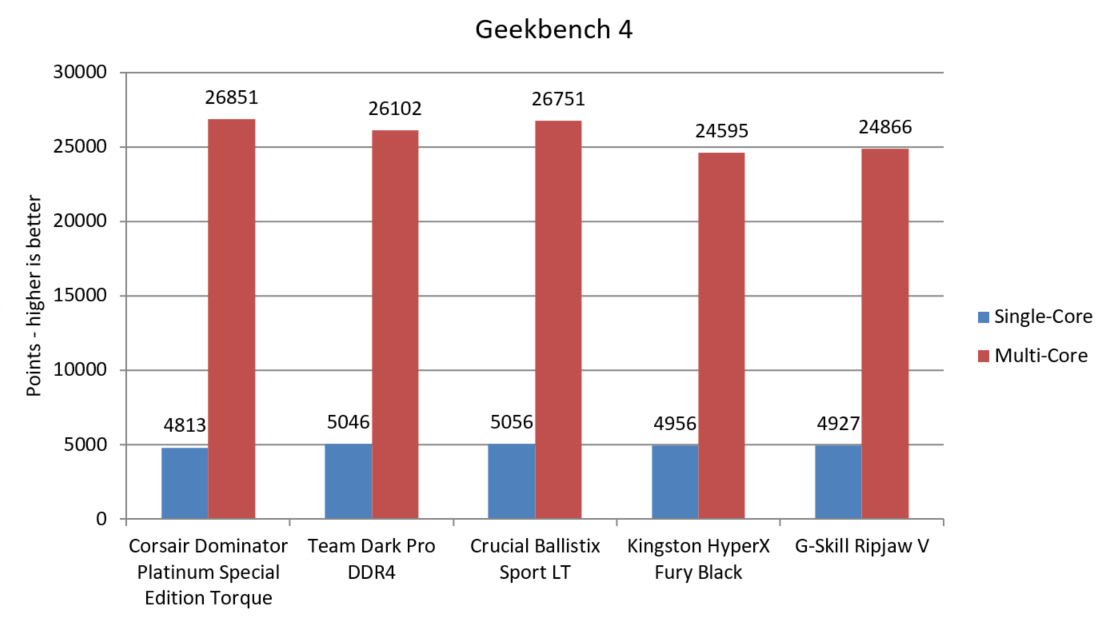
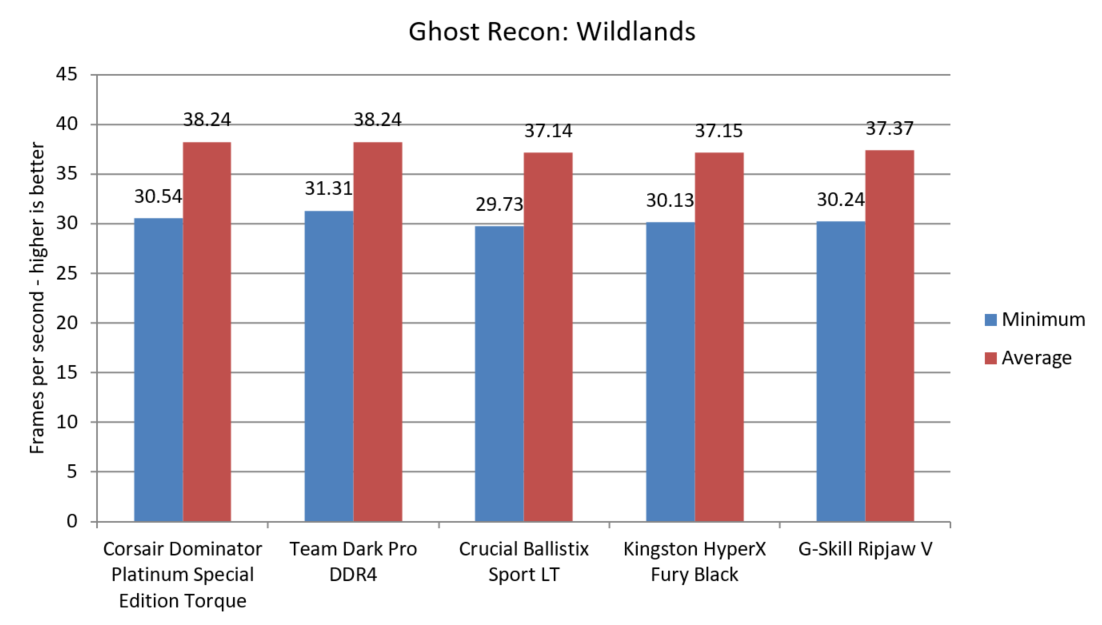
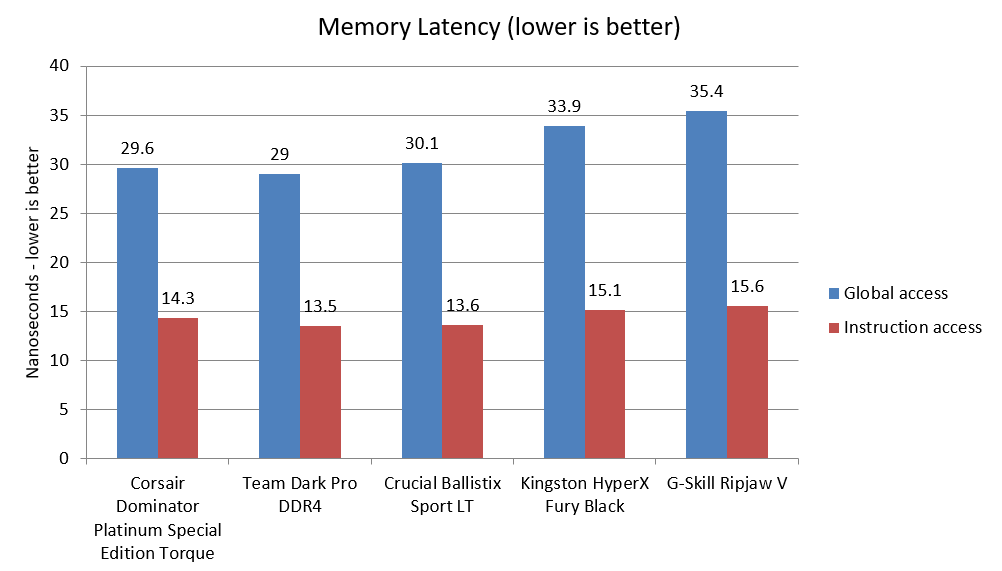
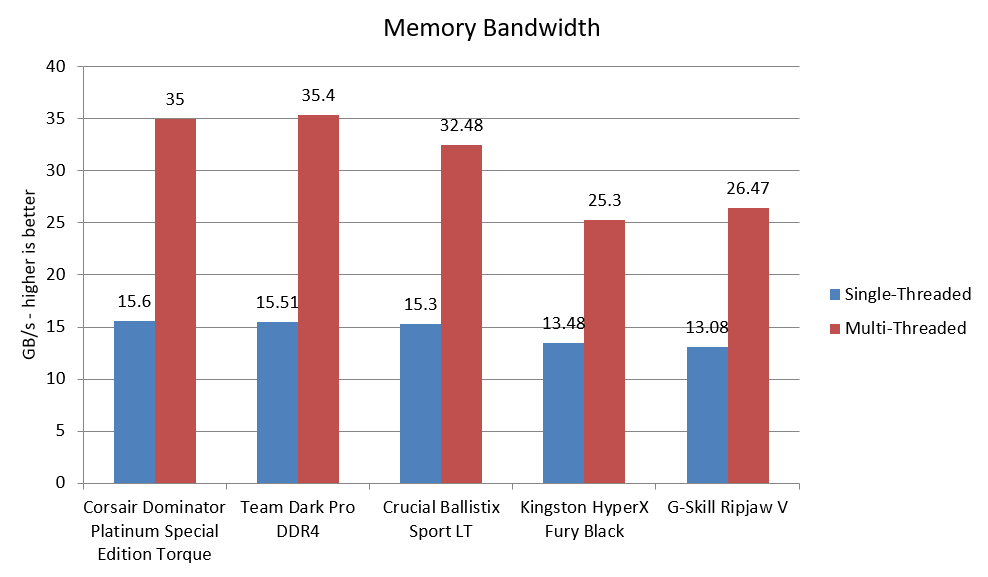

Best of the rest – Mid-range memory
My top mid-range kit was the Team Group Dark Pro, which proved that you don’t need more than 8GB of memory to perform to a high standard in a slew of benchmarks.
As ever, though, some people will need more capacity – and the market is packed with alternatives.
The second-place mainstream kit comes from Corsair. Its Vengeance RGB kit (CMR16GX4M2C3000C15) is decorated with RGB LEDs and sturdy metal, and the £155 price for a 16GB, 3000MHz kit plants it firmly in the middle of the group. It’s a consistent performer, with solid results in every benchmark and especially impressive speeds in Cinebench’s application tests. It’s also the best bet for gaming thanks to reasonable Ghost Recon pace and decent results elsewhere.
I could also recommend the Kingston HyperX Fury Black 16GB (HX426C16FB2K2/16) for gaming, because its Ghost Recon figures were the best of all the mid-range kits – but this doesn’t tell the whole story. It’s quick in those tests, but the poorest mid-range kit in almost all other benchmarks – no surprise when its 2666MHz speed falls behind most of its rivals.
The remaining mid-range kits did little to stand out. The Crucial Ballistix Tactical (BLT2C8G4D30AETA) looks good thanks to gunmetal grey design, it’s pleasingly low profile, and it has great theoretical pace. However, its real-world performance is slow and inconsistent, and its £10.50 per gigabyte price is the highest in the mid-range group.
G.Skill’s Trident Z (F4-3200C16D-16GTZB) has a middling price of £9.87 per gigabyte and boasts a 3200MHz clock speed and bright metal design, but nothing stands out beyond its looks – it’s entirely ordinary in virtually every benchmark.
Kingston’s HyperX Predator (HX424C12PB3k2/32) costs £10 per gigabyte, so it also falls into mid-table – but, impressively, it’s the only mid-range kit to serve up a huge 32GB of memory. Its 2,400MHz clock speed means it’s unable to impress in any of the theoretical tests, its application scores were slow, and it was inconsistent in games – its solid Ghost Recon minimum fps was undermined by the group’s worst average fps. That said, it’s a decent option if you’d like 32GB of memory without spending a relative fortune.
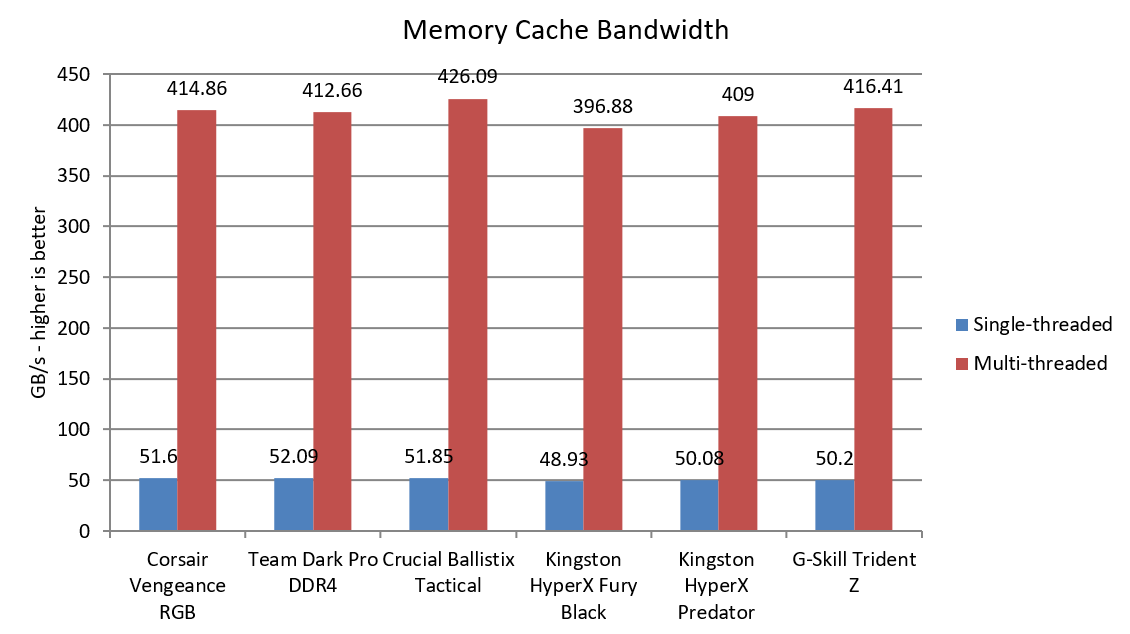
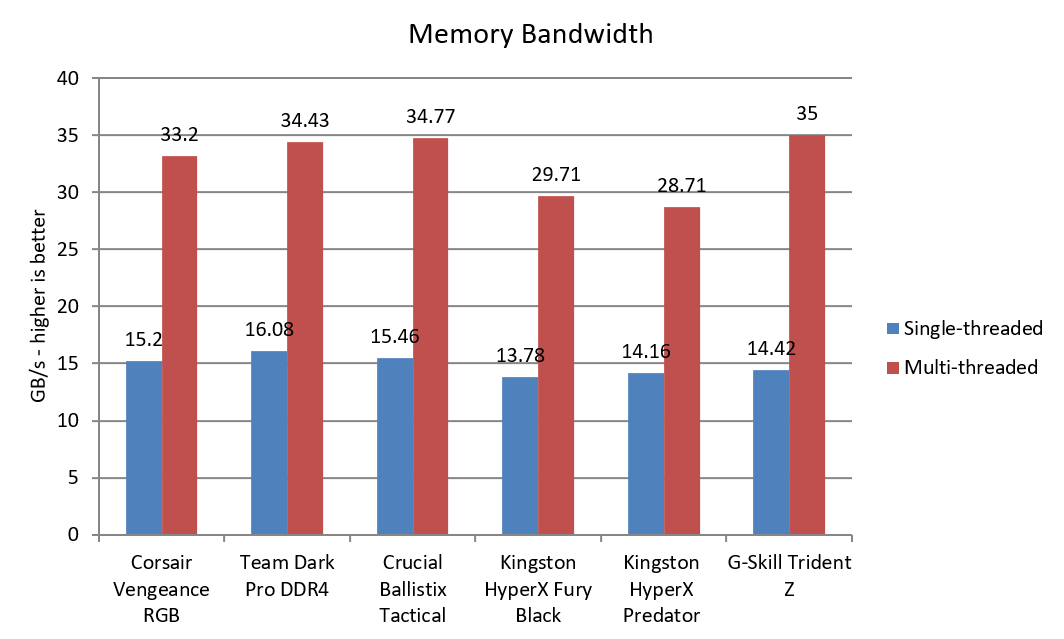
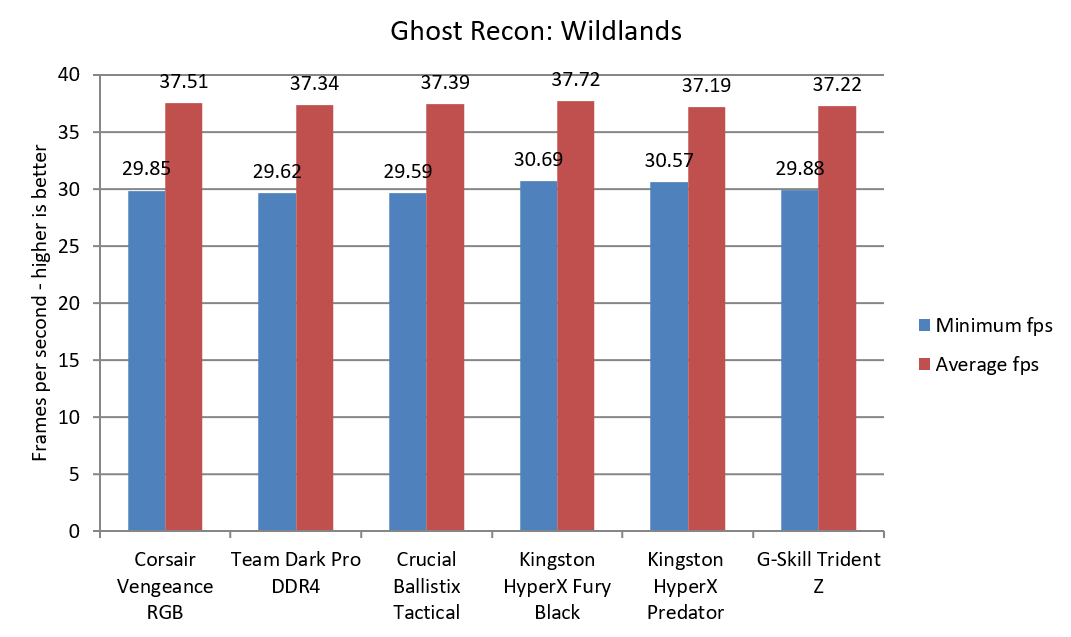

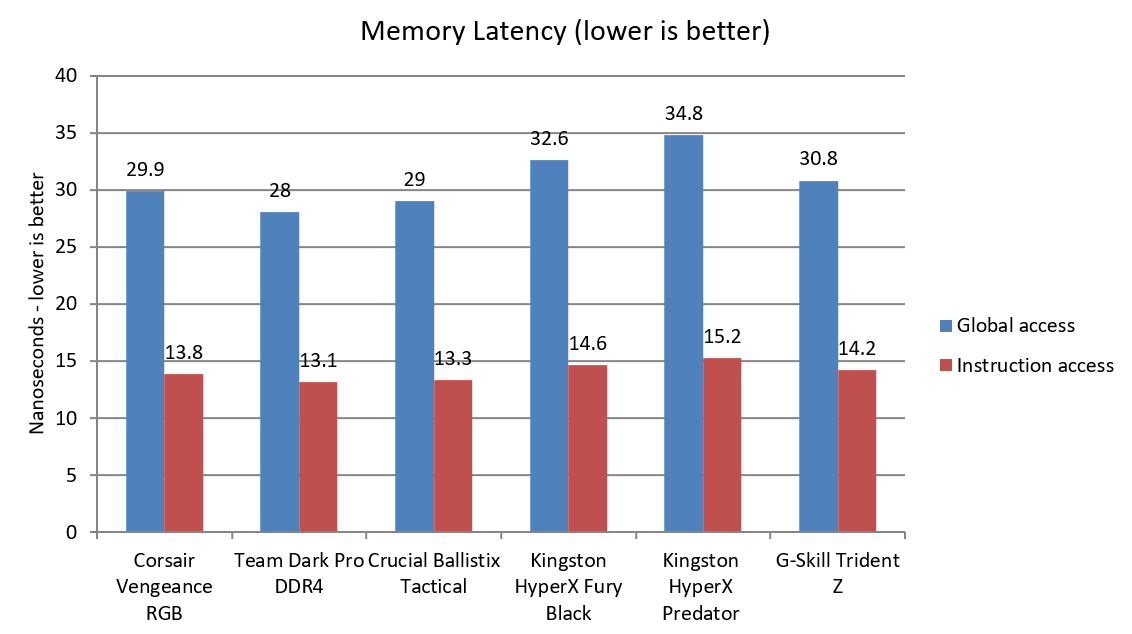
Best of the rest – High-end DDR4
The second-place kit in the high-end test comes from Team Group. Its Dark Night Hawk RGB (TF1D416G3200HC16CDC01) kit mixes outlandish angled design with RGB LEDs, and its £170 price translates to £10.62 per gigabyte – a decent price for a kit sporting such design and a 3200MHz clock speed.
It served up table-topping scores in precisely half of my theoretical benchmarks, and it was excellent in Geekbench too. However, it fell behind in gaming benchmarks and proved disappointing in Cinebench’s tests. As a result, it slips behind the Corsair, which was more consistent.
Crucial’s Ballistix Elite kit didn’t live up to its name. This memory has a mighty 3466MHz clock speed and a rock-solid metal design, but it fell into the middle of the results tables when it came to performance across all the tests. It isn’t bad at all, but it was never able to outpace other kits. And, at £12 per gigabyte, it’s expensive.
The G.Skill Trident Z RGB (F4-3200C14D-16GTZR) is another particularly expensive kit, and it comes with plenty of lighting and a great-looking brushed metal design. At £220 for 16GB of 3200MHz DDR4, it’s the priciest high-end kit, but its performance was the most inconsistent. It led the way in a couple of tests, propped up the table in others, but mostly stayed in the middle of the pack.
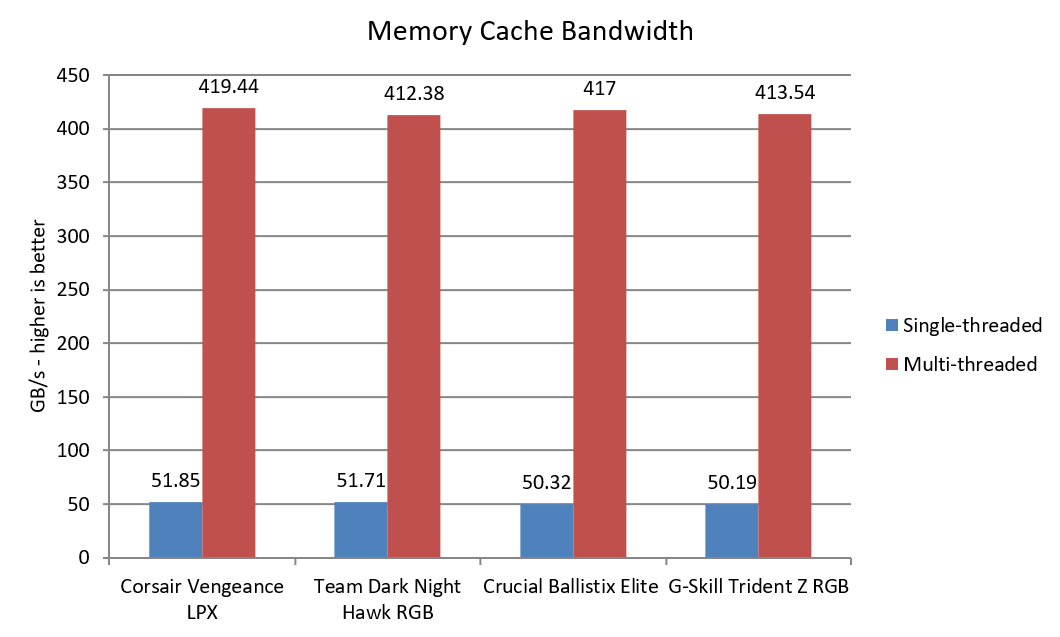
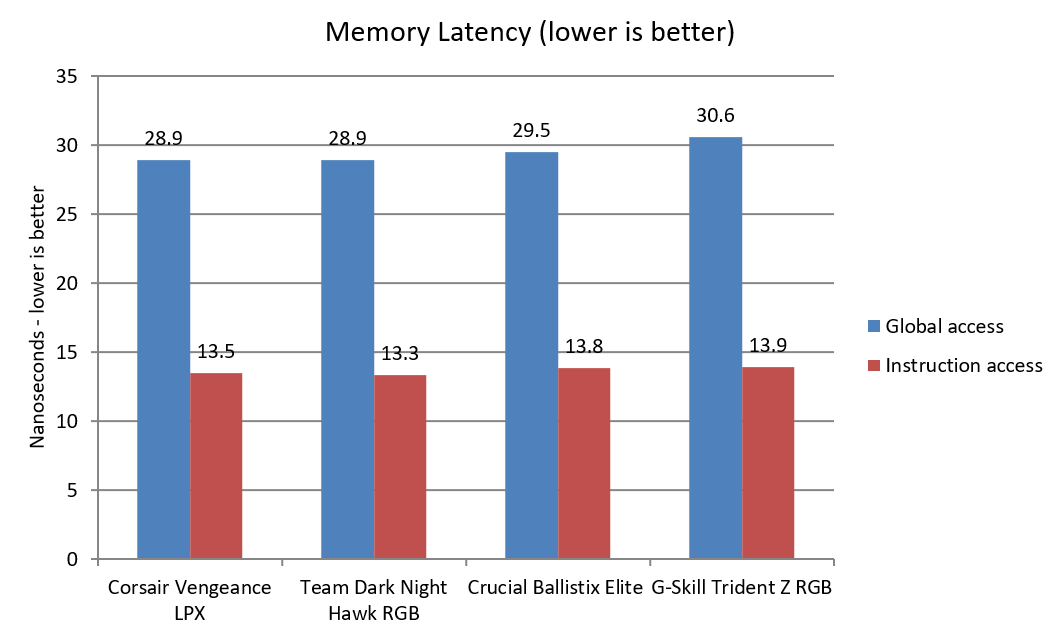
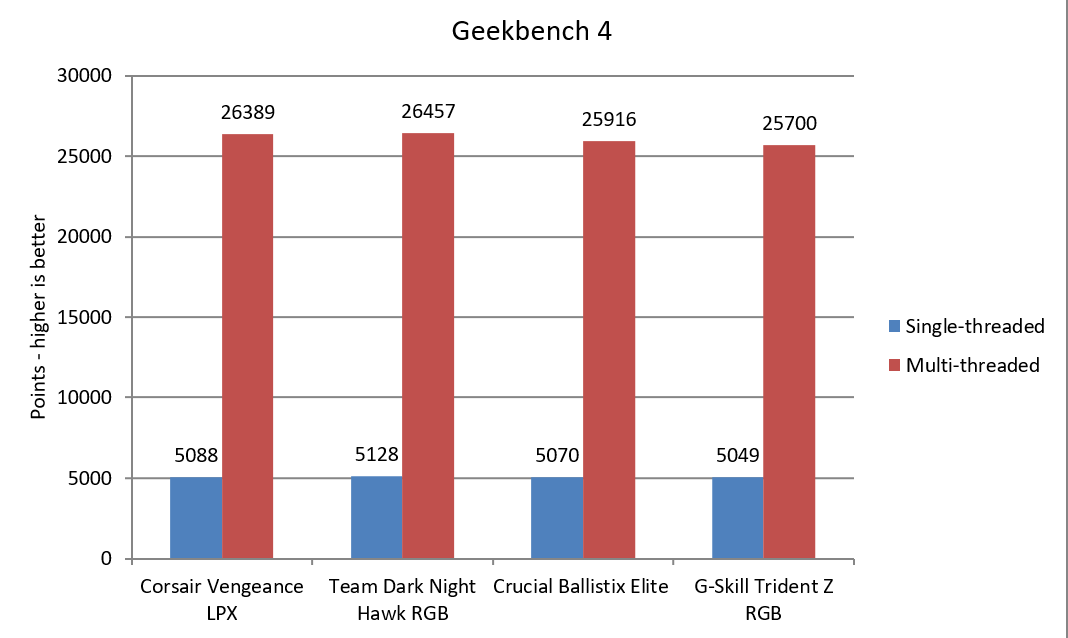
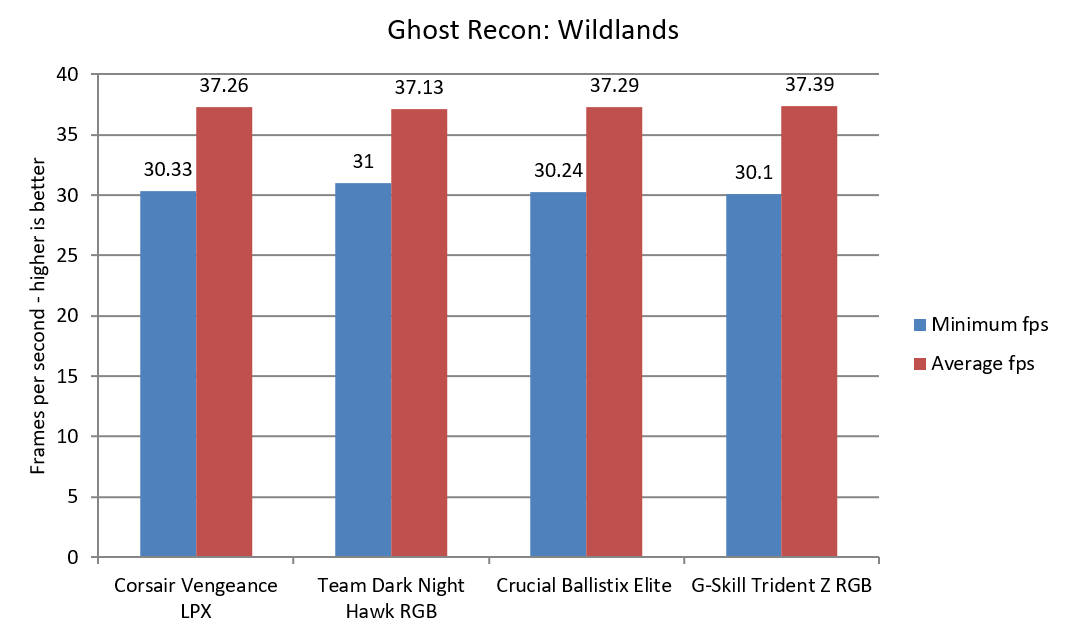
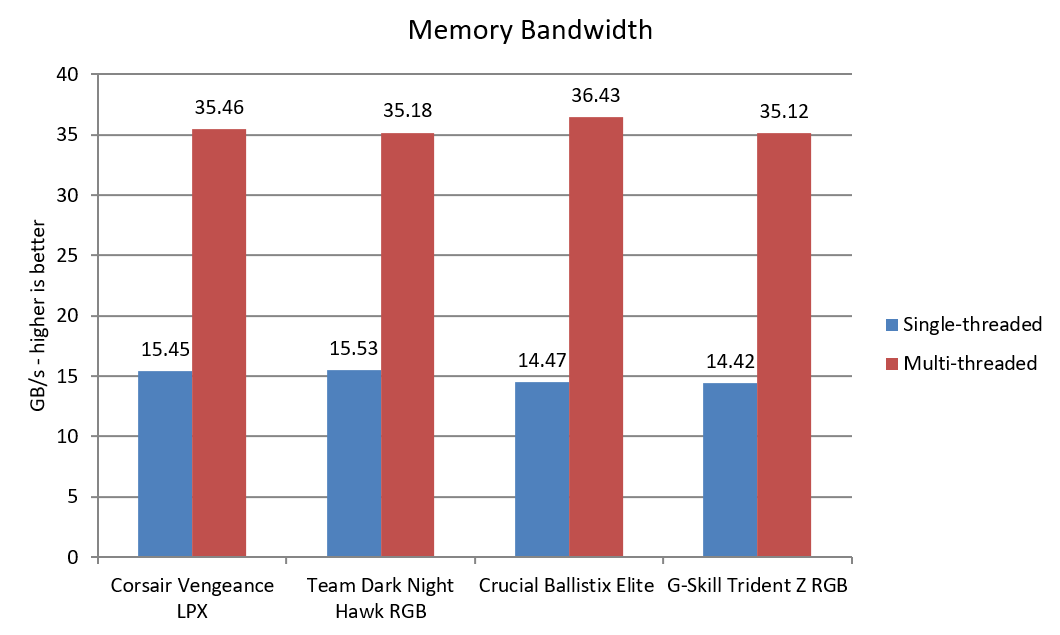
DDR4
What is it good for?
The current generation of PC memory, DDR4, was introduced way back in 2013. We don’t expect DDR5 modules to be available until 2020 at the earliest.
DDR4 offered improvements on its predecessor in several ways. For starters, speeds are better: DDR3 memory ran between 800MHz and 2133MHz, but DDR4 runs at 2133MHz and above.
Capacities have improved, too, with the maximum amount per module now 512GB rather than 128GB. That’s a theoretical limit for most users, because they just won’t need that much RAM, but it’s nice to see the march of progress.
Related: RAM for beginners
DDR4 memory sticks consume less power than their DDR3 equivalents, but their latency is also a little higher. In theory, this means response times will be slower, but DDR4’s increased speeds eliminate that bottleneck.
There have been a host of cosmetic changes arrive in the DDR4 market too. The big trend is RGB LEDs, which allow the sticks to display any colour in a host of patterns. Those colours can be customised in software, from within Windows. Many high-end memory kits now have RGB LEDs built into their designs to help users put together choreographed, consistent machines.
Elsewhere, we’re seeing more metal on memory sticks – chunky aluminium DIMMs and brushed metal is now commonplace, even on budget products.
Related: All of our PC component guides
What do you need?
It’s always important to consider how much memory you need and the speed required.
Handily, there are some simple rules to follow. These days, 4GB won’t be sufficient for anything other than a basic system. Instead, 8GB is the mainstream benchmark – this is enough memory to handle general-purpose computing and gaming without causing serious speed or performance issues.
If you have the cash to spend then 16GB is ideal. This will ensure that every current game will run smoothly, and it’s also enough to handle almost any work application.
There’s no real need to install 32GB of memory unless you regularly use high-end workstation or video editing applications; if you’re not using that kind of software then having 32GB of RAM is just a waste.
As a rule, it’s best to avoid 2133MHz memory if you can – at that low speed you’re likely to see performance drop, as the tests demonstrate. Memory clocked to 2400MHz won’t be brilliant, either.
We always recommend that people buy 2666MHz memory – or quicker, if the budget can stretch – to achieve the best balance between price and performance. At that level, the performance reduction is far smaller and more manageable when compared to true high-end kits.
At the high-end, meanwhile, most users don’t need to go beyond 3200MHz. At this level, you’ll see diminishing returns when it comes to performance boosts, so only the keenest of overclockers and benchmarkers need apply.
We’ve stuck to consumer-grade kit for this test, but we may stray towards 4000+MHz RAM in the future…
Related: Best Intel processor
What’s that weird latency figure?
Latency is a key memory specification, but it’s a bit of a mystery compared to more obvious attributes like speed and capacity. Latency figures refer to the time it takes for a processor to send a command and for the memory to respond.
Memory kits quote three or four latency figures that’ll appear as “15-17-17-35” on a manufacturer or retailer’s website. These represent different kinds of operations that memory will be asked to perform: the first figure is the main CAS latency figure, which represents the CPU asking for data and the memory releasing it. Other numbers represent tasks like switching to other lines of data, or the time taken for memory to activate and begin working.
These figures can be multiplied with the speed of the RAM’s clock cycle to give a result in nanoseconds, which is how long tasks take to complete. DDR4 memory generally has clock cycles that range between 12.5ns and 15ns, so I’m talking about incredibly fine margins – tiny differences that won’t make any sort of noticeable different to most machines. Broadly speaking, though, the lower the better.
Related: Best desktop PC
Consider your computer
It isn’t only about picking some memory sticks; you need to consider the rest of your system before you click on the checkout button.
On the Intel side, DDR4 works with Skylake (Intel 6th-gen Core) and Kaby Lake (Intel 7th-gen Core) processors, the 8th-gen Core chips and with Haswell-E and Skylake-X chips, and the recently-launched 9th gen processors.
This means you’re covered when it comes to more conventional consumer chips from the Pentium range right up to Core i7 and beyond, including the powerful, high-end beasts that Intel produces for workstation machines.
That’s great, but also look at Intel’s chipsets; the silicon on your motherboard will on occasion determine the kind of memory you can use. The chipsets used for Haswell-E and Skylake-X processors support quad-channel memory, which means you can use four sticks at once. The chipsets for Skylake and Kaby Lake support only dual-channel DDR4. We’ve only tested dual-channel memory here.
We’d also advise a browse of motherboard websites before you make a final buying decision. Every motherboard will support DDR4 at its conventional speeds, but pricier products will also support memory overclocking – so you’ll sometimes be able to run DDR4 at speeds that are way beyond 4000MHz.
The last time we tested DDR4 in 2016, the situation on AMD hardware was murky, but it’s now far better. AMD has now released its Ryzen processors, which offer full support for DDR4 memory at speeds of up to 2666MHz – although that figure will be increased to more conventional limits by motherboard manufacturers.
All of AMD’s new Threadripper processors use the Zen architecture, and all support quad-channel memory. The red team’s conventional Ryzen processors support dual-channel DDR4, just like Intel’s equivalents.
Related: Best AMD Ryzen CPUs
How we test DDR4 memory
We’ve tested all these kits on a machine with an Intel Core i9-7900X processor, Asus ROG Strix X299-E Gaming motherboard and Nvidia GeForce GTX 1080 Ti graphics card. This is a stupendously powerful PC that would normally run quad-channel memory; the specs of this machine means RAM will always be the bottleneck of performance, which is perfect for benchmarking.
The tests start with SiSoft Sandra, which runs each memory kit through a host of synthetic tests that are used to evaluate bandwidth, latency and throughput in a variety of scenarios.
After that, we use Cinebench and Geekbench, which provide a full-system benchmark for single- and multi-threaded performance, so we can determine the difference that memory kits make in these real-world scenarios. We’ve also tested in 3DMark and Ghost Recon: Wildlands to find out which kits are best for gaming.
What DDR4 will be making its way into your next gaming PC? Let us know on Facebook or Twitter @TrustedReviews.


